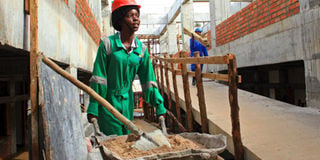Safety tips at the construction site

Protective gear should be worn at all times even when there is no threat of danger. Photo by Rachel Mabala
The building and construction industry is prone to many serious accidents especially for the site workers. From falls to accidents with power tools or machines, heavy lifting accidents, being buried by collapsing buildings, there is so much that can happen at and around a construction site.
Fred Ocen, a construction lawyer with Milton and Company Advocates, explains that ensuring safety on the site is everybody’s responsibility. “It is important that both the contractors and laborers ensure their own safety although the contractor has a bigger responsibility,” Ocen clarifies.
Ocen adds that according to Section 13 of the Occupational Safety and Health Act, 2006, the employer is more obliged to ensure health, safety and welfare of persons at the workplace.
The Act states: “Employer must take measures to keep the workplace pollution-free by employing technical measures, applied to new plant or processes in design or installation, or added to existing plant or process; or by employing supplementary organisational measures.
Employers must ensure safe working environment including its vicinity. Proper arrangements should be made to ensure safety and absence of health risks related to the use, handling, storage and transport of articles and substances. Provision and maintenance of workplace which is adequate regarding facilities and arrangements for the welfare of worker is also important.”
“But in a situation where the contractor provides for instance protective gear but the labourer neglects to use it, the latter can be held for contributory negligence,” Ocen clarifies.
He advises contractors to work hand in hand with their employees to develop safety and health strategies and adhere to them.
Protective gear
According to Topheal Bigambo, an engineer with Bwebo interior designs and building contractors LTD, one of the effective ways to ensure safety at a site is to provide personal protective equipment (PPE). These include helmets, gloves, footwear and masks among others. “When on site, all workers, visitors, and managers should wear the required safety equipment,” Bigambo tips.
He advises contractors to give their employees adequate training and instruction so that work can be performed safely and securely. He appeals to site supervisors to effectively supervise and monitor that work is being performed safely and that instructions are followed.
“Ugandans are generally lax about health measures such as wearing helmets or appropriate foot wear even if it is availed. It is important to hold an orientation programme at the beginning of the project and keep updating the information regularly most preferably every morning,” Bigambo advises.
According to Godfrey Tumwebaze, an engineer with EREKT Construction Company, the safety and health measures depend on the way the projects are planned. “Most of the construction sites around our country are not planned to the dot. Engineers forget that even the smallest things such as a one inch nail matters when building,” he observes.
Hire professionals
To ensure safety at a site, Tumwebaze advises that clients must hire certified professionals. “Professionals will stick to the best practices and principles such as properly planning for every material to be used. This will prevent improvisation which might compromise the strength and design of the structure thereby averting deadly accidents,” he observes.
Schedule all visits
All visits to the site should be properly scheduled. Visitors and workers on the site should be registered daily to allow for smooth distribution of safety gear everyday. He further advises engineers to keep the site as clean and hazard-free as possible.
Mathias Omona, a civil engineer with specialty in structural engineering and member of Uganda institution of professional engineers, cautions against change of plans. “The contractor must follow the given structural. Once any of the instructions are not followed, for example loading more floors than the ones designed for, then a building will be weakened,” Omona advises.
Another safety measure is ensuring that the materials used are not counterfeit. Engineers should do their own control quality to complement the work done by Uganda Bureau of Statistics.
A construction site has very expensive building materials such as cement, equipment that might attract thieves. As a safety measure, the construction area should also be secured well. A system to check every individual or car entering or leaving the site should be devised.
Site fatalities
In April 2016, Kyaseka towers, located on Makerere Hill Road opposite Makerere University main gate collapsed killing four people and injuring five others.
Eng Andrew Kitaka, the director of engineering at Kampala Capital City Authority (KCCA), later told journalists that KCCA engineers had inspected the building a week earlier and directed the site engineers to resubmit their plan for assessment. Apparently the six-storey building had been constructed with counterfeit materials. Earlier in 2008, a five-storey building had collapsed killing 10 people and trapping more than 20 others.
The cause was once again linked to shoddy building, criticising some firms for using substandard materials or insufficient cement to cut back costs.




